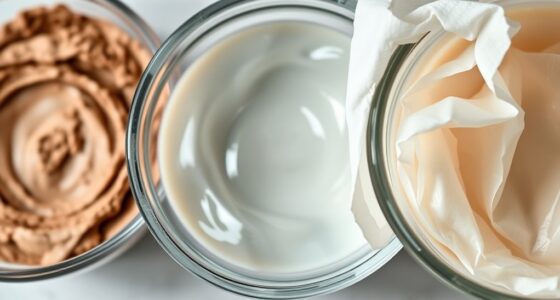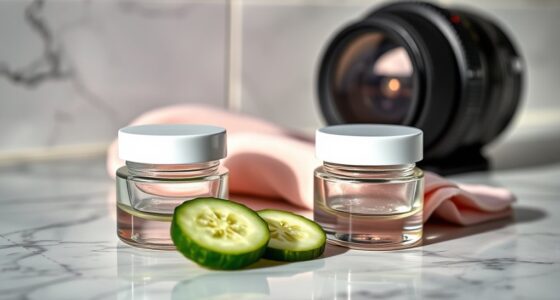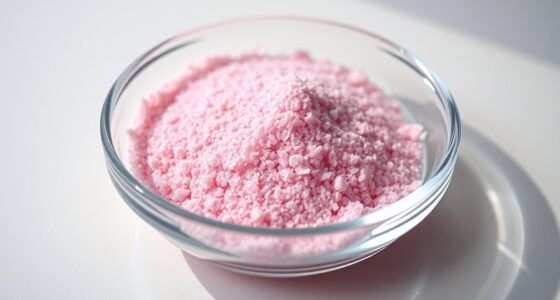Your skin craves a balanced pH, typically between 4.0 and 6.0, with the sweet spot being 4.5 to 5.5. This balance helps protect against bacteria and irritation. An imbalance can cause dryness, sensitivity, or even conditions like eczema and acne. To maintain optimal pH, use gentle, pH-balanced skincare products and avoid harsh chemicals. You’ll discover more tips for ensuring your skin stays healthy and radiant as you explore further.
Key Takeaways
- Maintaining skin pH between 4.5 and 5.5 is essential for healthy skin and its protective barrier.
- Use pH-balanced skincare products to support your skin’s natural defenses and prevent irritation.
- Avoid harsh cleansers and exfoliants that can disrupt your skin’s pH balance and lead to dryness.
- Regular moisturizing helps maintain the acid mantle and supports overall skin health.
- Monitor your skin’s pH with test strips and be aware of products that may alter its balance.

Your skin’s pH balance plays a crucial role in its overall health, typically hovering between 4.0 and 6.0 on the pH scale. This slightly acidic environment is vital for maintaining your skin’s natural defenses. The ideal pH for healthy skin is often cited as being between 4.5 and 5.5. This balance is largely due to the acid mantle, a thin layer of sebum and sweat that protects against harmful bacteria and other pathogens. Maintaining a healthy skin pH can also be supported by consuming a balanced diet, which includes whole foods and nutrient diversity. Additionally, using essential oils such as lavender can help promote skin health and balance. Regular cleaning of your skin can also enhance its ability to maintain an optimal pH balance, as removing dirt and impurities supports its natural defenses.
Maintaining the right pH balance is essential. When your skin’s pH is imbalanced, you can face several issues, such as eczema, acne, or rosacea. Extremes in pH can compromise your skin’s natural barrier, leading to dryness, irritation, or redness. Keeping your skin within the ideal pH range helps maintain its appearance and resilience, ensuring it looks and feels healthy.
Several factors can cause pH imbalances. Environmental influences, like harsh skincare products, can disrupt your skin’s pH levels. Additionally, consuming alcohol may also play a role. Using products that are too alkaline can strip away your skin’s acid mantle, while overly acidic products, like strong peels, can lead to irritation. Even everyday household items can have high pH levels that negatively affect your skin.
When your skin’s pH is too high, it becomes alkaline, leading to dryness and fragility. Alkaline conditions increase your susceptibility to irritation and compromise the skin’s protective barrier. This can trigger conditions such as eczema or dry skin (ichthyosis) and may accelerate aging and the formation of wrinkles.
On the flip side, oily skin tends to have a lower pH, making it more acidic. While acidity can help maintain the protective barrier, extremely low pH levels might cause irritation or conditions like rosacea and eczema. Balanced pH is crucial for healthy skin, as it helps protect against bad bacteria and maintains the microbiome.
To maintain your skin’s pH balance, opt for pH-balanced skincare products that align closely with your skin’s natural range. Choose gentle, non-irritating cleansers to avoid disrupting the balance. It’s best to steer clear of harsh exfoliants; if you need to exfoliate, consider chemical options instead. Regular moisturizing is crucial for supporting your skin’s barrier function.
You might find toners helpful, but it’s wise to consult a dermatologist if you’re unsure about your choices. Testing your skin’s pH can be done at home with pH test strips or at a dermatologist’s office. Observing any changes in your skin, such as irritation or dryness, can give you important clues about its pH balance. Monitoring the pH of your products is key to ensuring your skin stays healthy and balanced, and being aware of how harsh products can impact your skin is essential for maintaining its health.
Frequently Asked Questions
How Can I Test My Skin’s Ph Level at Home?
To test your skin’s pH level at home, you can use pH test strips designed for skin.
Start by cleansing your skin and waiting about 15 minutes.
Then, apply the strip to a clean, dry area and wait for the color change.
Compare the result with the provided chart to determine your skin’s pH.
What Products Can Help Restore Skin Ph Balance?
To restore your skin’s pH balance, opt for gentle, pH-friendly cleansers like Puracy Natural Body Wash or Johnson’s Skin Balance.
Incorporate toners with ingredients like Witch Hazel or Niacinamide to refine your skin and maintain balance.
Look for products containing Vitamin C or Aloe Vera to soothe and enhance your skin’s condition.
Don’t forget to moisturize regularly with pH-balanced creams to keep your skin hydrated and healthy.
Does Diet Affect My Skin’s Ph Levels?
Oh sure, just keep munching on those potato chips and expect your skin to glow like a model’s!
Seriously, your diet does affect your skin’s pH levels. If you’re loading up on fruits, veggies, and healthy fats, you’re likely supporting a balanced skin pH.
But if you’re feasting on processed foods, get ready for a pH rollercoaster.
Can Skin Ph Affect Acne and Breakouts?
Yes, skin pH can significantly affect acne and breakouts.
When your skin’s pH rises above the normal range, it disrupts the barrier function, allowing bacteria like *P. acnes* to thrive. This can lead to increased inflammation and breakouts.
Maintaining a balanced pH through gentle cleansers and suitable skincare products helps support your skin’s natural defenses, reducing the likelihood of acne flare-ups and promoting a healthier complexion.
Are There Specific Ingredients to Avoid for Ph Balance?
When it comes to maintaining skin pH balance, you should avoid certain ingredients. Steer clear of parabens, sodium lauryl sulfate, and phthalates, as they can disrupt your skin’s natural acidity.
Also, watch out for harsh preservatives like methylisothiazolinone and formaldehyde, which can irritate your skin. Instead, choose pH-balanced cleansers and natural toners that help support your skin’s health while keeping its pH levels stable.
Your skin will thank you!
Conclusion
In the grand orchestra of skin health, pH balance is the conductor that guides each note to perfection. By keeping your skin’s pH in harmony, you’re not just protecting your complexion; you’re creating a vibrant masterpiece that radiates confidence. Embrace gentle cleansers, nourishing moisturizers, and a mindful skincare routine to ensure your skin sings in all the right tones. Remember, a balanced pH isn’t just a goal; it’s the foundation for your skin’s beauty and vitality.









